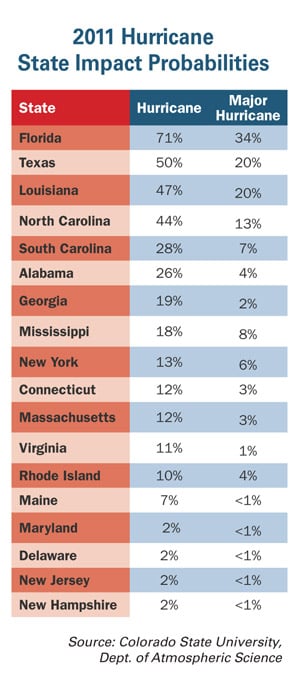 As the 2011 Atlantic hurricane season gets underway today, most forecasters indicate that it will be a busy year for storms with a high likelihood of a hurricane making landfall along the Atlantic and Gulf Coasts.
As the 2011 Atlantic hurricane season gets underway today, most forecasters indicate that it will be a busy year for storms with a high likelihood of a hurricane making landfall along the Atlantic and Gulf Coasts.
Maintaining its earlier predictions made on April 6, The Colorado State University hurricane forecast team of Phil Klotzbach and William Gray is still calling for 16 named storms in the Atlantic basin for the 2011 season, with five developing into major hurricanes.
"We are predicting the same levels of activity that were forecast in early April due to favorable atmospheric and oceanic conditions in the tropical Atlantic," says Gray, who is in his 28th year of forecasting at Colorado State. "We continue to anticipate an above-average probability of United States and Caribbean major hurricane landfall."
Recommended For You
Want to continue reading?
Become a Free PropertyCasualty360 Digital Reader
Your access to unlimited PropertyCasualty360 content isn’t changing.
Once you are an ALM digital member, you’ll receive:
- Breaking insurance news and analysis, on-site and via our newsletters and custom alerts
- Weekly Insurance Speak podcast featuring exclusive interviews with industry leaders
- Educational webcasts, white papers, and ebooks from industry thought leaders
- Critical converage of the employee benefits and financial advisory markets on our other ALM sites, BenefitsPRO and ThinkAdvisor
Already have an account? Sign In Now
© 2025 ALM Global, LLC, All Rights Reserved. Request academic re-use from www.copyright.com. All other uses, submit a request to [email protected]. For more information visit Asset & Logo Licensing.








